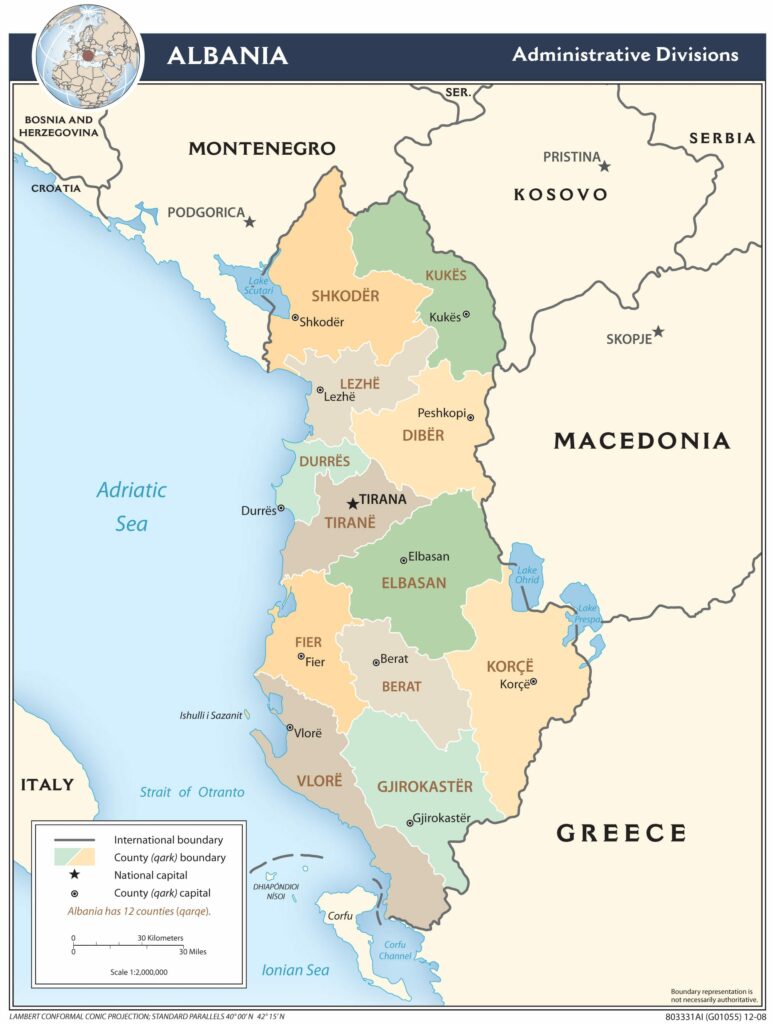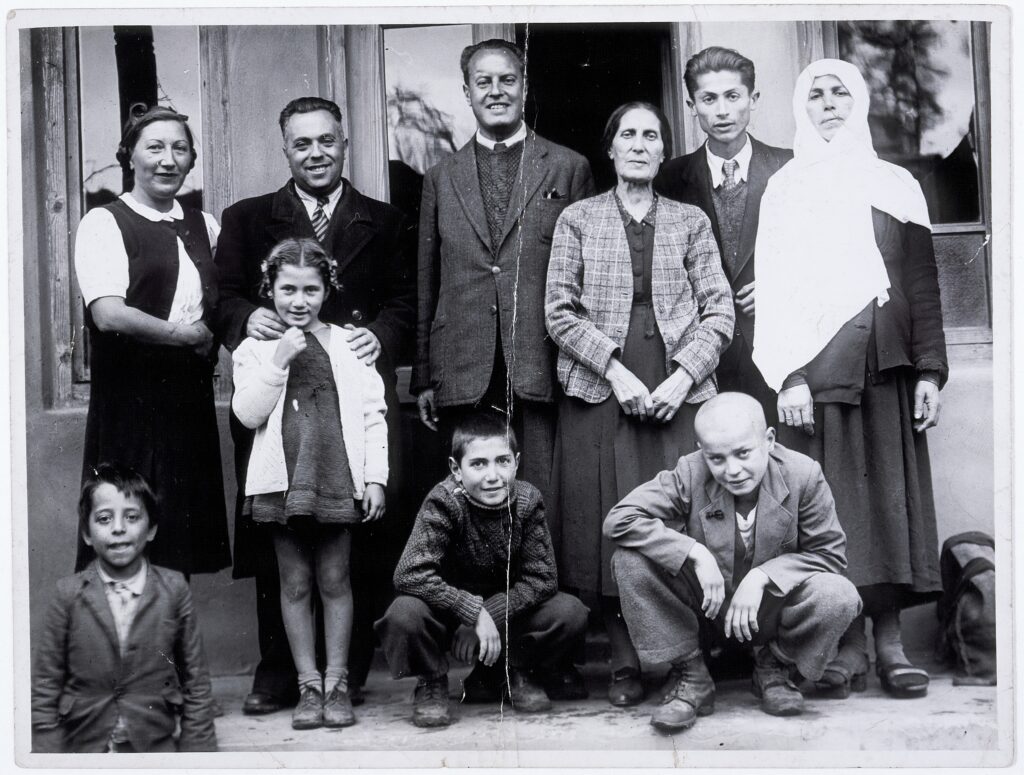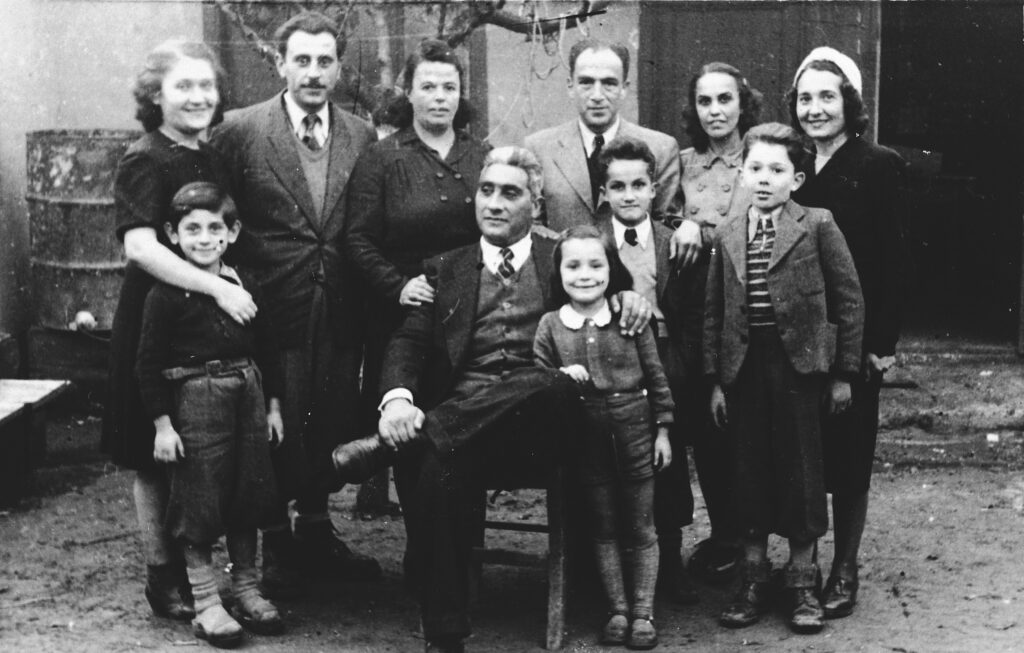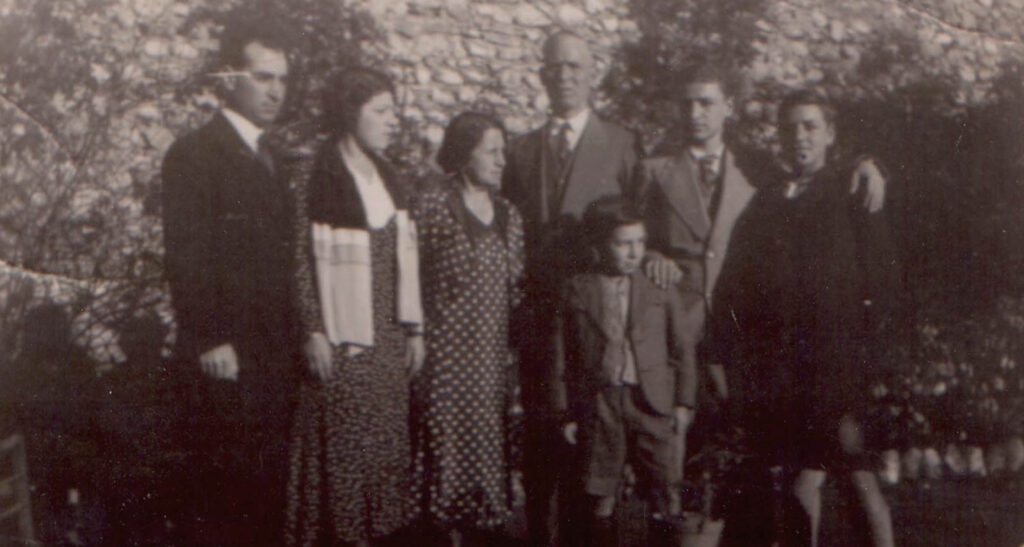“There is no religious or race prejudice in that country on the Adriatic”1
Herman Bernstein (US Ambassador to Albania, 1930-1933).
Background
As a recipient of the EHRI-Conny Kristel fellowship, I spent a short research period at the Fondazione Centro Di Documentazione Ebraica Contemporanea (CDEC) in Milan, Italy. CDEC is an independent research institute for the study of the history and culture of Jews in Italy, with particular reference to contemporary Italy and the Nazi-fascist period. The CDEC Foundation is broadly recognized as the main institute in Italy for the history and documentation of the Shoah.2 The time I spent at CDEC was fundamental for my research, which is focused on the fate of native and foreign Jews in Albania during the Holocaust. CDEC contains a significant number of documents, books, and other materials, directly and indirectly connected to the experiences of Jews in Albania before and throughout World War II (WWII).
Please follow the link for the EHRI institution description of the CDED:
Albania was the only Nazi-occupied country with more Jews after WWII than before. Almost all native Jews survived the Holocaust, and other thousands of Jewish refugees were protected during the period from 1939 to 1945. The tradition of Besa, a moral commitment to society, was the main motivation underlying these altruistic acts.3 Besa is the crucial element of the Doke or Kanun, an unwritten pagan code that most probably originated from Illyrian tribal laws.4 Rescue in Albania can be divided into three main periods: King Zog’s reign (January 1933 – April 1939), the fascist Italian occupation (April 1939 – September 1943), and the Nazi German occupation (September 1943 – November 1944).

In the first period, Jewish refugees from other nations were openly invited and assisted by the Albanian government. The local Jewish community was well integrated in the Albanian society and could practice their religion openly.5 Many of them owned small enterprises, mostly in urban areas, such as Vlorë, Durrës and Berat. Government officials and diplomats followed the King’s order to grant visas and citizenship to every Jew that necessitated living in Albania.6 The country was used as a safe transit station to reach more stable territories, outside the influence of Hitler. King Zog did not implement fascist policies in his country, despite the deep financial dependence on Mussolini’s Italy.7 He tried until the last days before the fascist invasion to preserve the independence of the country, despite not being successful.
During the second period of rescue, thousands of Jewish refugees remained trapped in Albania, but despite that, arrivals continued at a high rate. The Italian authorities ordered the repatriation of every foreign Jew, but they were never forced to leave the country.8 Albanian and foreign Jews were relatively safe during the fascist rule, but they were excluded from any political involvement. Moreover, they lived under continuous fear of being targeted for deportation to concentration camps and elimination.


Of course, the risk was much greater during the third period of rescue when the country fell under German occupation. The Nazis ordered an automatic death penalty for anyone who hid partisans and Jews.9 Regardless of this fact, the Jewish refugees were received and supported by numerous families and individuals. Further, the Albanian puppet authorities were never diligent in pursuing and persecuting the Jews. They repeatedly refused to comply with the Nazis’ request for the submission of lists of Jewish residents.10 The Arditi family were (most probably) the only Jewish family whose members did not survive the Holocaust. In October 1944, they were arrested by the local Gestapo, after being sued by an Albanian from Shkodër. Luna, Leon, Dario, Lucia and Ugo Arditi were deported to Dachau and murdered by the Germans.11

Albania was liberated by the National Liberation Movement (NLM) on November 29, 1944. The NLM, also known as the Antifascist National Liberation Movement, was a communist resistance organization, which had the support of the vast majority of the population. The NLM partisans also played a significant role in the liberation of Kosova, Montenegro and parts of Bosnia and Herzegovina. Albania was amongst the most devastated and destroyed countries after WWII. The United Nations Relief and Rehabilitation Administration (UNRRA) reported 30.000 deaths, hundreds of demolished villages, and 100.000 people left homeless in a population of less than one million. 12
An incredible story
It is against this background that one of the most interesting documents found in the CDEC’s collection can be appreciated. This is the first original memoir of Johanna Jutta Neumann, which she finished writing in February 1983 and then donated to the Foundation.13 This is perhaps the most interesting document related to the rescue of Jews in Albania during the Holocaust years. Johanna was born on December 2, 1930, into a family of merchants in Hamburg, Germany. According to Johanna’s notes, her father, Siegbert Gerechter, had been a German army officer in a machine gun division, and had received the Iron Cross for his service during World War I (WWI). Furthermore, he had received an additional medal in 1935 as a frontline fighter for four years, and his brother had fallen for Germany in WWI. These facts gave him a (false) sense of security, and he never seriously thought about immigrating until 1938. On December 22, 1938, Johanna and her parents received short-term visas from the Royal Albanian Consulate in Berlin. Their plan was to use Albania as a transit point before heading to New York. They had to leave quickly and all they could take were a few suitcases and only ten Marks per person.
On March 1, 1939, the Gerechters and other Jewish-German families arrived in Durrës, Albania. Johanna describes her new country as very primitive and unhygienic; most of the Jewish refugees suffered from different types of intestinal problems, including diarrhea, typhoid fever, and malaria. They received modest financial support from Jewish humanitarian organizations, as well as from the Albanian government. The country was soon invaded by the fascists, but as Johanna testifies, they never gave her family any trouble. However, the Italian authorities did not allow the Gerechters to exit Albania when the Consul in Naples invited them to receive their visas for entry into the United States. Mussolini had previously passed antisemitic legislation and had forbidden Jewish immigration. In the second half of 1940, the Gerechters and other Jewish families living in the port city of Durrës were forced to move to Berat, a small town in south Albania. Generally, they were welcomed and made to feel at home by the local community. In Johanna’s words:
“I guess we were considered poor and food and gifts were sent to us from all sides. This is probably the first time that we heard of pilaf and baklava, which we received in large quantities. Our Muslim neighbours also invited us to come to the Mosque with them, which we did. In such a small village people are very friendly. Albanians in general are very hospitable.” 14
In the summer of 1941, the Gerechters came back to Durrës, where they rented a room in a farm house along the seashore. Other Jewish refugees and the Albanian landlord lived with their families in separate rooms of the house. The Gerechters stayed in Durrës until 1943, when the country was invaded by the Germans. They moved initially to Krujë, a small town in central Albania. Johanna and her parents lived with the Pilku family, pretending to be their relatives. The Pilku’s home was often visited by SS officers, but they were never discovered even though everyone in the town knew that they were Jews. During 1943-1944, the Gerechters lived in hiding in different places in Tirana, helped and protected by the Pilkus and other Albanians. On September 28, 1945, Johanna and her parents left Albania and moved to Italy, before heading to their final destination, the United States. They lived for nearly a year in a displaced persons camp in Tricase Porto, in southern Italy, where they learned for the first time about the atrocities the Nazis committed during the Holocaust.
The account of Johanna Jutta Neumann constitutes one of the most important testimonies of Jewish refugees situation in Albania during WWII. Johanna and her family stayed in Albania for more than six years. Her memoirs, interviews and speaking engagements, are unique and invaluable resources for researchers interested in the history of Jews in the Balkans, and on their fate during the Holocaust period.
Future research and related archival sources
The number of authors and studies that deal with the history of Jews in Albania and with their situation during the Holocaust period is still insignificant. Scholars must continue to search, organize, and analyze documents as well as share witnesses’ testimonies and personal stories. As the Holocaust historian Michael Berenbaum notes, “We’re in a transitional moment. The last survivor is soon going to die, and then we go from living memory to historical memory.”15
The story about the Albanian rescue of Jews began to come to light only after the fall of communism, in the 1990s. Following WWII, Albanians experienced decades of repression and extreme isolation. The country was ruled by Enver Hoxha, the leader of the Party of Labour, who imposed the most radical version of Marxism-Leninism in Eastern Europe. In November 1967, Albania was declared the first atheist state in the world. The practice of any faith, including Judaism, was severely punished.16 In the early 1990’s, with the collapse of the regime, almost all the remaining Jews left the country.17 In May 1990, the United States delegation, headed by Congressmen Tom Lantos and Joseph DioGuardi, visited the country for the first time after WWII.18
After a (relatively) short period of research on the situation of the Jewish community in Albania during the years from 1933 to 1945, I can conclude that the most relevant archival sources related to the topic are stored in the following institutions:19
- Central State Archive of the Republic of Albania (Arkivi Qëndror Shtetëror);
- Yad Vashem (The World Holocaust Remembrance Center) Archives;
- Italian Central Archives (Archivio Centrale dello Stato);
- German Federal Archives (Bundesarchiv).
The collections of Yad Vashem in Jerusalem are probably the main source of reflections and testimonies of both Holocaust survivors and Albanian rescuers of Jews.20 The United States Holocaust Memorial Museum (USHMM) in Washington also contains several invaluable photos, video and audio testimonies, and other resources related to the Holocaust period in Albania. Furthermore, the YIVO Institute for Jewish Research, based in New York, contains a complete collection of documents of the life and career of Herman Bernstein, United States Ambassador to Albania in the 1930s.21 Bernstein was not only a diplomat, but also a translator, journalist, author and Jewish activist. The collection includes private correspondence, memos, papers, translations, and photographs.
My EHRI-Conny Kristel mobility at CDEC was an opportunity not only to consult numerous archive materials, but also to exchange experiences and discuss cooperation with the Foundation’s esteemed researchers, professors and other experts in the field.
- YIVO Institute for Jewish Research Archives, Herman Bernstein Papers, Record Group 713 (Selected materials on Albania), Folder 760, Page 68. ↩
- https://www.cdec.it/. ↩
- Harvey Sarner, Rescue in Albania: One Hundred Percent of Jews in Albania Rescued from Holocaust (Cathedral City, California: Brunswick Press, 1997); Norman H. Gershman, Besa: Muslims Who Saved Jews in World War II (Syracuse, New York: Syracuse University Press, 2008); Visar Malaj, “Albanian Customary Law, Religion, and the Rescue of Jews during the Holocaust,” Holocaust and Genocide Studies, 36, no.3 (2022): 372-385. ↩
- See, for example, Mary Edith Durham, Some Tribal Origins, Laws and Customs of the Balkans (London: Allen, 1928); Hasluck, The Unwritten Law in Albania (Cambridge, UK: Cambridge University Press, 1954). ↩
- David Cesarani, Daniel Fraenkel, Guy Miron, David Silberklang, and Aharon Weiss, “Albania,” in Encyclopedia of the Holocaust, ed. Robert Rozett and Shmuel Spector (New York: Routledge, 2013), 104. ↩
- See, for example, “Albania’s King Zog Extends Invitation to Jewish Settlers,” The American Jewish World, June 7, 1935. ↩
- David Straub, “Jews in Albania,” in Encyclopedia of the Jewish Diaspora: Origins, Experiences, and Culture, ed. Mark Avrum Ehrlich (Santa Barbara, California: ABC-CLIO, 2009), 942–46. ↩
- Ibidem. ↩
- See, for example, The Righteous Among the Nations Database (Yad Vashem), file M.31.2/5858. ↩
- Sarner, Rescue in Albania, 43; Cesarani et al, “Albania,” 104. ↩
- https://www.yadvashem.org/righteous/resources/rescue-of-jews-in-albania-through-yad-vashem-files.html. ↩
- Charles Sudetic, “Historical setting,” in Albania: A Country Study, ed. Raymond E. Zickel and Walter R. Iwaskiw (Washington, D. C.: Library of Congress, Federal Research Division, 1994), 37. ↩
- CDEC Collection, Id 12869, Inv. 00003511, Coll. B.8647, Year 1983. ↩
- Ibidem. ↩
- https://www.aju.edu/newsroom/exploring-resilience-holocaust-survivors-unimaginable-circumstances. ↩
- Article 55 of the 1976 Constitution stated: “Ndalohet krijimi i çfarëdo organizate me karakter fashist, antidemokratik, fetar dhe antisocialist. Ndalohet veprimtaria dhe propaganda fashiste, antidemokratike, luftënxitëse, si edhe nxitja e urrejtjes kombëtare e racore. (The creation of any organization with a fascist, anti-democratic, religious and anti-socialist character is prohibited. Fascist, anti-democratic, and war-mongering activity and propaganda, as well as the incitement of national and racial hatred, are prohibited.)” ↩
- Sarner, Rescue in Albania, 92. Today the number of Jews residing in Albania is less than 50. ↩
- https://balkaninsight.com/2023/04/12/albania-to-honour-heroes-who-saved-jews-from-holocaust/. ↩
- am collecting, translating and analyzing hundreds of documents related to the topic. ↩
- For a concise description and analysis of the Albanian files of the Righteous Among the Nations Department, see the paper of Iael Nidam-Orvieto and Irena Steinfeldt, available at https://www.yadvashem.org/righteous/resources/rescue-of-jews-in-albania-through-yad-vashem-files.html. ↩
- See YIVO Institute for Jewish Research Archives, Herman Bernstein Papers, Record Group 713 (Selected materials on Albania). ↩
Tomislav Buljan
And Kurt Waldheim? A Kurt Waldheim? Why was he so long spared of responsability?
Eleanor
Thank you for this article. An Albanian friend of mine here in Vancouver, named Niko, shared this article, which is enlightening and touching. I appreciate your writing this history for readers.
Visar
Dear Eleanor: thank you for your nice words 🙂